Schaan
Schaan (German pronunciation: [ʃaːn]) is the largest municipality of Liechtenstein by population. It is located to the north of Vaduz, the capital, in the central part of the country. As of 2019 it has a population of 6,039[2] making it the most populous administrative district in Liechtenstein, representing an important traffic hub and industrial location of the country. Schaan covers an area of 26.8 km2 (10.3 sq mi), including mountains and forest. It is a municipality within the electoral district of Oberland in the Principality of Liechtenstein. Schaan has four enclaves, two of which belonging to Vaduz and Planken.
Schaan | |
|---|---|
Municipality | |
 Church of St. Laurentius | |
Flag 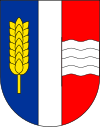 Coat of arms | |
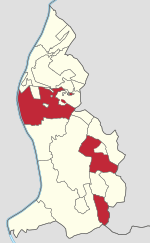 Schaan and its exclaves in Liechtenstein | |
| Coordinates: 47°10′00″N 9°30′35″E | |
| Country | |
| Electoral district | Oberland |
| Villages | none |
| Area | |
| • Total | 26.8 km2 (10.3 sq mi) |
| Elevation | 450 m (1,480 ft) |
| Population (31-12-2019)[1] | |
| • Total | 6,039 |
| Time zone | UTC+1 (CET) |
| • Summer (DST) | UTC+2 (CEST) |
| Postal code | 9494 |
| Area code(s) | 7005 |
| ISO 3166 code | LI-07 |
| Website | www.schaan.li |
History
Recent archaeological finds have shown that Schaan has been inhabited for over 6000 years: In the year 15 BC, The Romans conquered, under Augustus, the territory of the present Principality of Liechtenstein and built the Roman province of Raetia. In the 1st century AD, a Military Highway from Milan-Bregenz was created, which ran along the Luzisteig along the right bank of the Rhine, leading to the building of settlements in modern-day Schaan. Also from the 1st century AD are two Roman legionnaire's helmets, which were found in 1887 during digging work above Dux and probably as dedications of the two Roman legionaries Publius Cavidius Felix and Numerius Pomponius, whose names are engraved on the helmets, buried here. They are now housed in the museums of Bregenz and Zurich. The most important Roman building on the municipal land is a fort built in the valley, which was built to protect against the ever more frequent Alemannic invasions. Remains of its foundations and the gate tower are again visible from St. Peter's Church, Schaan. A baptistery from the 5th century, which was found during excavations inside this church, suggests an early Christianization. During excavations, there were also older traces of settlement from prehistoric times.
The Alemannic settlement document numerous grave finds. At that time Schaan consisted of two separate parts: The Romanized Räter-people had their centre at St. Peter, while the Alemannic population settled in the area of Specki. This dichotomy can still be seen today in the existence of two alpine cooperatives, the North-Alemannic cooperative Gritsch and the southern Rhaeto-Romanian cooperative Guschg.
Geography
Schaan is the northernmost municipality in the Liechtenstein Oberland. It is bordered to the south by the capital, Vaduz, to the east by Planken and Triesenberg, and to the north by the municipalities of Eschen and Gamprin. In the west, the Rhine forms the natural border with Switzerland, and in the east, the town is dominated by the Three Sisters mountain range. Schaan also has four exclaves within other municipalities, and two enclaves within its municipality.
Climate
| Climate data for Schaan | |||||||||||||
|---|---|---|---|---|---|---|---|---|---|---|---|---|---|
| Month | Jan | Feb | Mar | Apr | May | Jun | Jul | Aug | Sep | Oct | Nov | Dec | Year |
| Average high °C (°F) | 2.6 (36.7) |
4.8 (40.6) |
9.5 (49.1) |
13.8 (56.8) |
18.1 (64.6) |
21.3 (70.3) |
23.4 (74.1) |
22.5 (72.5) |
19.7 (67.5) |
14.1 (57.4) |
8.1 (46.6) |
3.4 (38.1) |
13.4 (56.1) |
| Daily mean °C (°F) | −0.6 (30.9) |
1.1 (34.0) |
4.9 (40.8) |
8.8 (47.8) |
12.9 (55.2) |
16.2 (61.2) |
18.3 (64.9) |
17.6 (63.7) |
14.8 (58.6) |
9.8 (49.6) |
4.6 (40.3) |
0.4 (32.7) |
9.1 (48.4) |
| Average low °C (°F) | −3.7 (25.3) |
−2.6 (27.3) |
0.4 (32.7) |
3.9 (39.0) |
7.8 (46.0) |
11.2 (52.2) |
13.2 (55.8) |
12.7 (54.9) |
10.0 (50.0) |
5.6 (42.1) |
1.1 (34.0) |
−2.5 (27.5) |
4.8 (40.6) |
| Average precipitation mm (inches) | 67 (2.6) |
62 (2.4) |
65 (2.6) |
87 (3.4) |
106 (4.2) |
132 (5.2) |
130 (5.1) |
140 (5.5) |
103 (4.1) |
76 (3.0) |
79 (3.1) |
76 (3.0) |
1,123 (44.2) |
| Source: Climate-data.org[3] | |||||||||||||
Education
There are four kindergarten sites: Malarsch, Pardiel, Rebera, and Werkof. The Gemeinschaftszentrum Resch, Primarschule provides primary school services.[4]
Realschule Schaan and Sportschule Liechtenstein are in Schaan, while Realschule Vaduz and Oberschule Vaduz are in the Schulzentrum Mühleholz II in Vaduz. Liecht. Gymnasium is also in Vaduz.[5]
There is a private Waldorf school that has students from, in addition to Liechtenstein, Austria and Switzerland. It was established in 1985.[6]
Notable people
- Maria Linden (1869–1936 in Schaan) a German bacteriologist and zoologist
- Gerta Keller (born 1945 in Schaan) Professor of Paleontology and Geology at Princeton University since 1984.[7]
- Roman Hermann (born 1953 in Schaan) a Liechtensteiner former cyclist
- Paul Frommelt (born 1957 in Schaan) a former Alpine skier
- Peter Jehle (born 1982 in Schaan) footballer who plays for Liechtenstein club FC Vaduz as a goalkeeper
- Ivan Quintans (born 1989 in Schaan) a Liechtensteiner footballer
Gallery
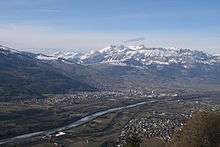 Buchs SG, Grabs SG, Gams SG in Switzerland and Schaan
Buchs SG, Grabs SG, Gams SG in Switzerland and Schaan Town hall of Schaan
Town hall of Schaan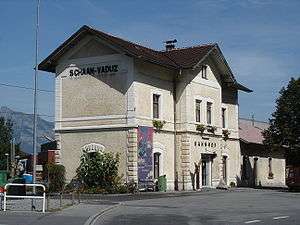
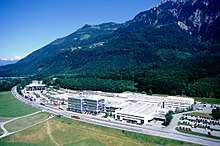 Headquarter of Hilti AG
Headquarter of Hilti AG
References
- (in German) 2014 statistics for Liechtenstein
- https://www.llv.li/files/as/bevolkerungsstatistik-30-juni-2017.pdf
- "Climate: Schaan, LI". Climate-data.org.
- "Strassenplan" (Archive). Commune of Schaan. Retrieved on May 12, 2016.
- "Weiterführende Schulen Schaan." Commune of Schaan. Retrieved on May 12, 2016. "Realschule Schaan Duxgass 55 9494 Schaan" and "Sportschule Liechtenstein Duxgass 55 9494 Schaan" and "Realschule Vaduz Schulzentrum Mühleholz II 9490 Vaduz" and "Oberschule Vaduz Schulzentrum Mühleholz II 9490 Vaduz"
- "Waldorfschule." Commune of Schaan. Retrieved on May 12, 2016.
- http://gkeller.princeton.edu/